Environment & Energy
Related: About this forumNuclear vs Solar Comparison of the Greenhouse Gas Emissions to Produce Electrolytic Hydrogen.
The paper I'll discuss in this post is this one: Considering Embodied Greenhouse Emissions of Nuclear and Renewable Power Plants for Electrolytic Hydrogen and Its Use for Synthetic Ammonia, Methanol, Fischer–Tropsch Fuel Production. Yu Gan, Clarence Ng, Amgad Elgowainy, and Jason Marcinkoski Environmental Science & Technology 2024 58 (42), 18654-18662.
Before discussing the paper, let me restate my oft stated opinion that electrolytic hydrogen is an appallingly stupid idea, particularly given that electricity is a thermodynamically degraded form of energy, and that electrolysis leads to further degradation and wasted energy. The half a century old crap about a putative "hydrogen economy" remains a pernicious but otherwise useless effort to rebrand fossil fuels as "green" since practically all of the hydrogen manufactured on this planet - accompanied by exergy destruction - is made using fossil fuels, and thus is driving, not preventing the extreme global heating we now observe.
A Giant Climate Lie: When they're selling hydrogen, what they're really selling is fossil fuels.
Hydrogen as an energy source itself is an appallingly stupid idea, given its horrible physical properties, the worst being its extremely low critical temperature, the third lowest of any known gas after each of the two stable isotopes of helium, its low viscosity, and its incompatibility with many materials, notably metals, in particular steel, which it embrittles.
However, in my general reading this one popped up conveniently in a journal I regularly read; it is just another in a long series of LCA (life cycle analysis) papers that pretty much say the same thing: Solar energy, which has been promoted not by people who are really interested in the tragic consequences of humanity's dependence on fossil fuels, but who exhibit very stupid fear and ignorance about nuclear energy, paranoia about it, has a higher climate impact than nuclear energy. Again, antinukes are not interested, in my opinion, in addressing extreme global heating. They couldn't care less about fossil fuels.
The paper is open to the public. Anyone can read it. Nevertheless, I'll excerpt it and reproduce a few graphics from it.
The first sentence in the paper, by the way, is a commonly stated lie. The world is decidedly not undergoing an energy transition. We are using more fossil fuels than ever, and the trivial solar industry, and the deliberately sabotaged nuclear industry which produces more than three times as much energy as solar energy at a cost that is just a fraction of the money squandered on solar, have not addressed or stopped the use of fossil fuels.
The introduction included the oft stated lie in the first sentence:
Renewable power-based electrolysis to produce clean hydrogen is usually considered to have zero emissions because of the zero-emission burden at the place of electricity production. However, this assumption may not be true when embodied emissions associated with renewable power plant materials, manufacturing, and installation. Embodied emissions of renewable power plants refer to the emissions associated with the entire life cycle of material extraction, processing, manufacturing, installation, and end-of-life treatment of power facilities. Although nearly emission-free electricity generation of solar photovoltaic (PV) systems over their 25–30 year lifespan, their manufacturing and installation necessitate energy and material inputs and result in emissions being produced. (1,2)
Several studies have examined the global warming potential of clean hydrogen production. Spath and Mann (3) found that hydrogen produced from wind electricity would have emissions of 0.97 kg CO2 e/kg H2 including embodied emissions. A subsequent review by Bhandari et al. (4) confirmed that hydrogen produced by wind electricity has the lowest emissions among hydrogen produced from different renewable and nuclear electrolysis. Cetinkaya et al. detailed the embodied emissions for five different H2 production methods, including three from renewable energies (solar PV, wind, and thermochemical water splitting using nuclear). (5) They found that GHG emissions from solar and wind electrolysis were 0.97 and 2.4 kg of CO2 e/kgH2, respectively. (5) This is backed up by Palmer et al. (6) as they reported that hydrogen from solar PV would have emissions of 2.3 kg CO2 e/kgH2. Motazedi et al. calculated emissions of hydrogen produced by high-temperature electrolysis to be 0.3 kg CO2 e/kg H2. (7)...
Graphics from the paper:
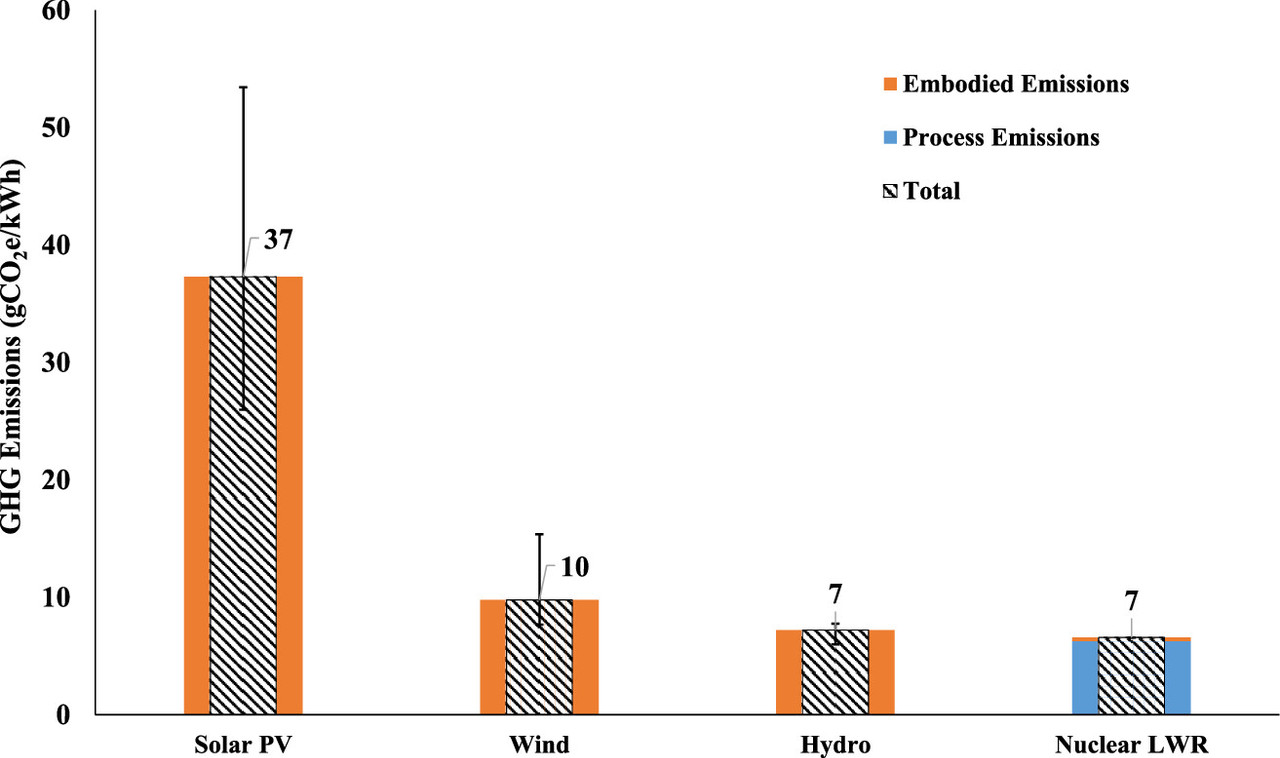
The caption:
The effort to claim that so called "renewable energy" is a de facto reactionary effort to return humanity to dependence on the weather, which was abandoned, beginning in the 19th century for a reason. Since the weather varies, so does the climate gas impact of so called "renewable energy" including what is often ignored, the embodied energy of producing the short lived infrastructure it represents:
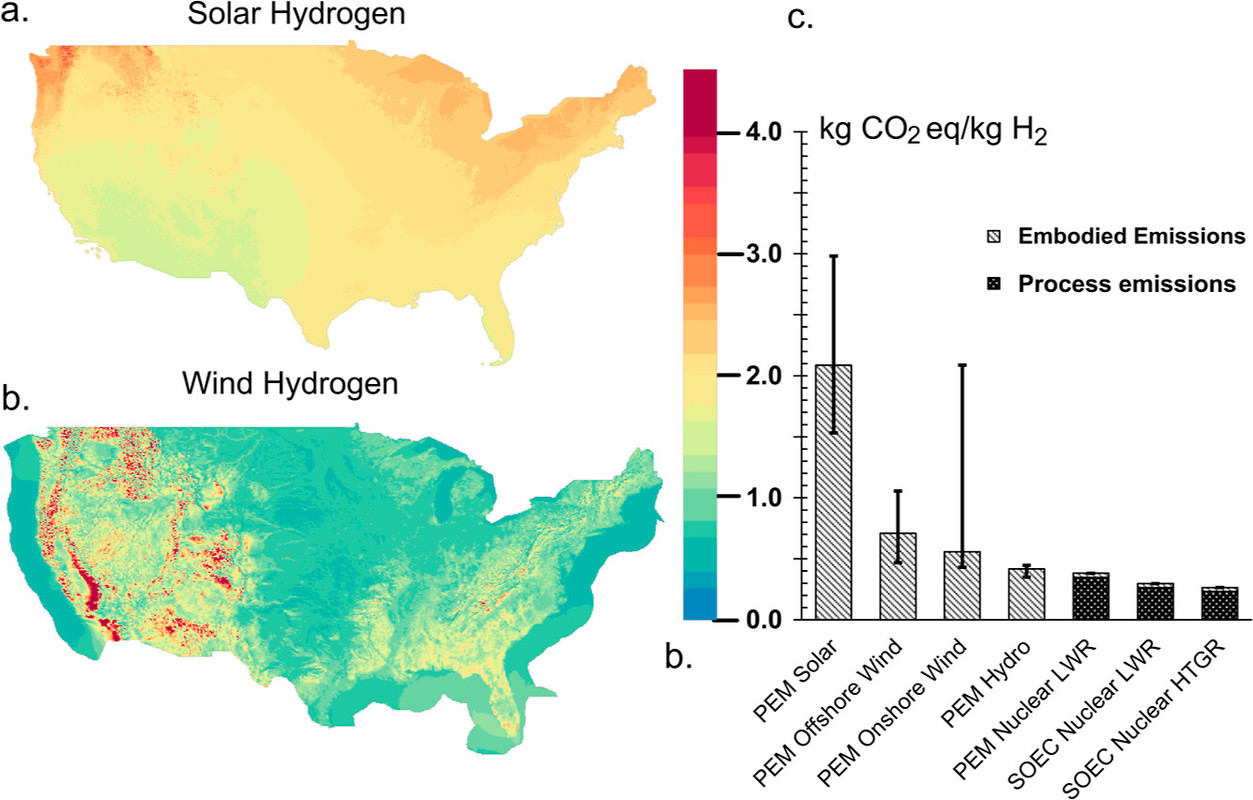
The caption:
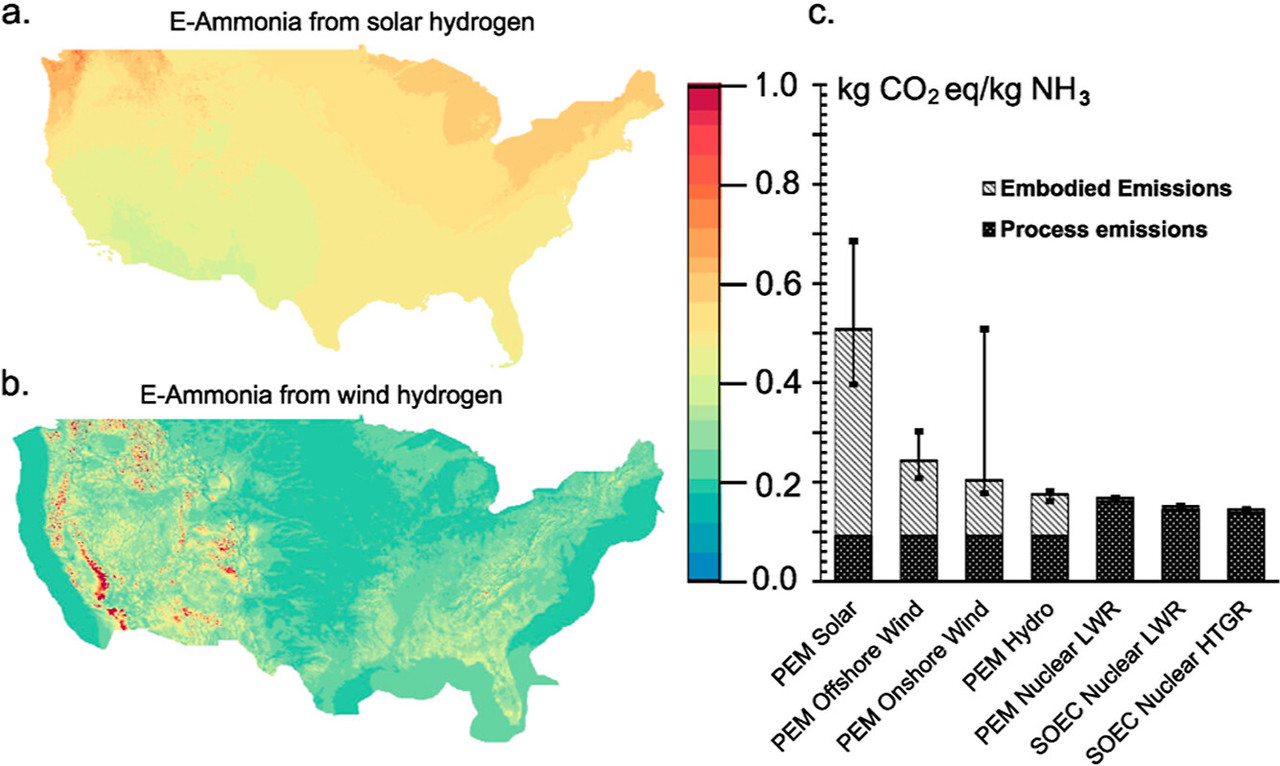
We hear a lot of bullshit around here, about hydrogen cars, hydrogen trucks, hydrogen buses (these expensive pieces of shit have been known to explode) etc. but the reality is that the main use for industrial hydrogen is in the chemical industry as a captive intermediate, the most important of which is for the production of ammonia, on which the world food supply depends. The next graphic points to that fact.
The caption:
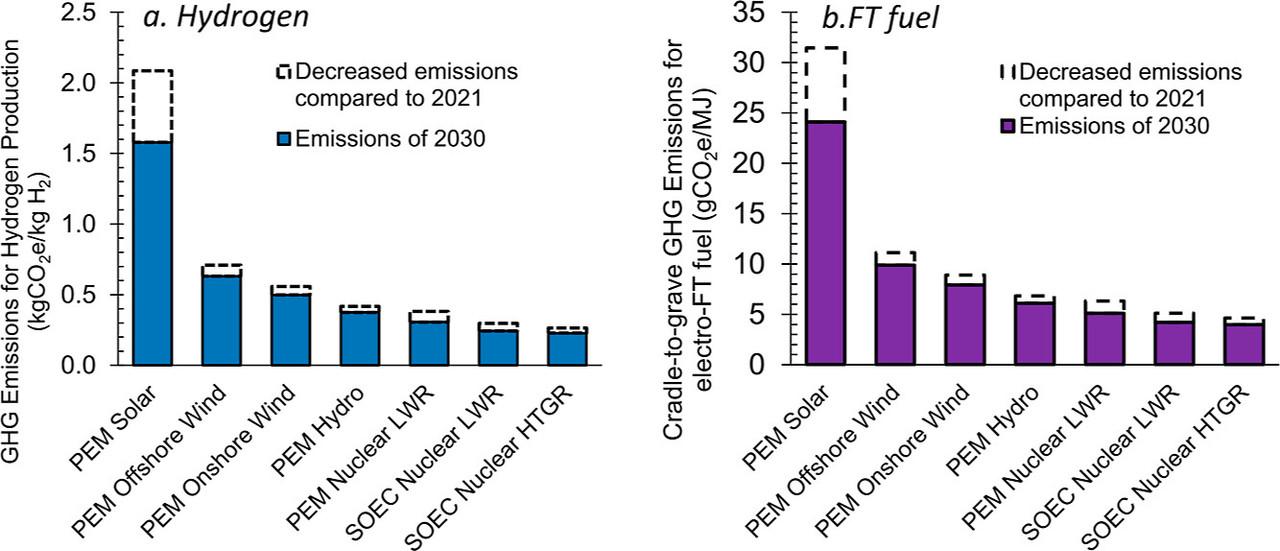
The caption:
A few additional excerpts from the paper:
...The embodied GHG emissions of hydroelectricity are estimated to be 7.2 g/kWh, slightly lower than that of wind power. This estimate does not account for the potential biogenic GHG emissions associated with hydroelectric reservoirs. These reservoirs can give rise to emissions of biogenic carbon dioxide and methane. (29) Such GHG emissions occur due to the decomposition of flooded vegetation and soil organic matter during the construction and operation of dams. The rate of carbon dioxide and methane flux per unit area of a reservoir varies significantly based on factors such as organic carbon content, reservoir age, and water temperature. (30)...
...Nuclear power plants with different reactor technologies have different embodied emissions, varying from the lowest of 0.16 g/kWh for the AHTR plant to the highest of 0.4 g/kW for the ABWR plant. The embodied emissions of the current U.S. fleet average nuclear power plants (consisting of ?65% power capacity from PWR and ?35% from BWR) are 0.3 g/kWh. The high capacity factor of an average of ?90% for the U.S. operating fleet contributes to the lower embodied emission intensity of nuclear electricity. Moreover, different from the solar and wind power plant, there is no age-related decline in capacity factor seen in the nuclear reactor performance, with average capacity factors and rated power increasing with age for reactors between 40 and 50 years old. (28) Thus, nuclear power plants have much higher lifespans than their renewable counterparts, many nuclear power plants in the U.S. have received license extensions from the initial 40 to 60 years, (28) and it is possible they will last from 80 to 100 years. The longer lifespan also leads to a lower embodied emission intensity of nuclear power plants...
Note that the lifespan of nuclear power plants, is the main driver in lowering their embodied energy costs.
Despite all the efforts of fossil fuel indifferent or active promoters here and elsewhere, hydrogen is a dirty fuel, since thermodynamically degraded electricity is a dirty fuel, produced overwhelmingly with exergy destruction, by the combustion of dangerous fossil fuels.
The 2024 WEO produced by the IEA makes this exceeding clear, as well (in the soothsaying columns) the amount of energy that would be wasted in efforts to make hydrogen as a fuel, which, again, is a dumb idea. To make 5 Exajoules of hydrogen "energy" would require 7 Exajoules of primary energy; thus hydrogen is a scheme to waste primary energy, thus making things worse not better.
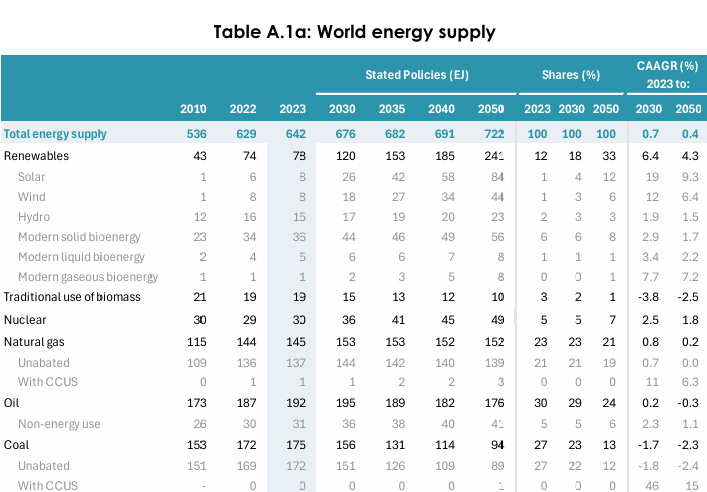
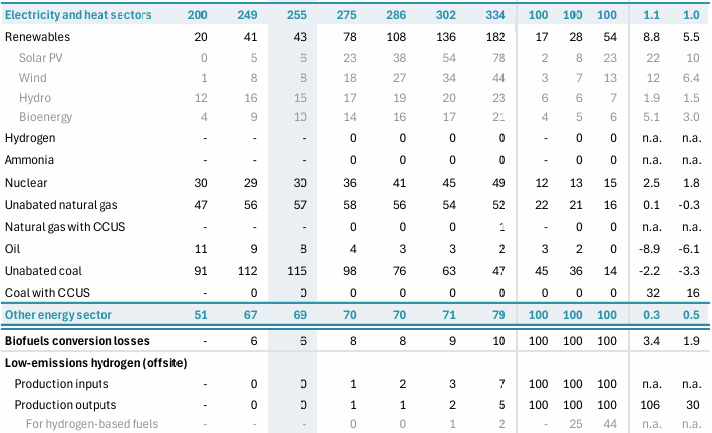
World Energy Outlook 2024
Table A.1a: World energy supply Page 296.
By the way, one should note that the people around here who are working to rebrand fossil fuels as "hydrogen" oppose nuclear energy. This should clarify what they're really about.
I'll return to this website to cover yet another in the series of accounts of the disastrous 2024 increases in concentrations of the dangerous fossil fuel waste CO2, compared to 2023, a series that will end when project 2025 shuts NOAA, but worth considering up to and including the ignorance apocalypse, of which hydrogen and so called "renewable energy" fantasies were a prelude, but things will get much, much, much, much worse as Stalinist type propaganda takes hold in our newly fascist country.
Think. Again.
(17,907 posts)...to the necessity of Green Hydrogen as an energy storage option for the transition away from fossil fuels!
Of course, the choice between solar, or wind, or hydro, or nuclear as the source for the electricity needed to produce the Green Hydrogen will be made on a case by case basis due to so many involved factors, but it's great to see that all these technologies are ready and waiting for the political will to start the race!